![]()
![]()
![]()
Use LEFT and RIGHT arrow keys to navigate between flashcards;
Use UP and DOWN arrow keys to flip the card;
H to show hint;
A reads text to speech;
107 Cards in this Set
- Front
- Back
- 3rd side (hint)
|
Jeremy decides to cook some pasta noodles. He notices that the directions say to add salt to the water before bringing the water to a boil. The next day, Jerry asks his science teacher, Ms. Jackson, a question: "how does adding salt affect boiling temperature of the water?" Of course, Ms. Jackson asks Jeremy to plan and conduct an experiment to find the answer?
• Jeremy writes an excellent hypothesis before beginning his experiment. Which of the following is the hypothesis he wrote? |
Adding salt to the pasta water will cause the water to boil at a higher temperature. |
|
|
|
Jeremy decides to cook some pasta noodles. He notices that the directions say to add salt to the water before bringing the water to a boil. The next day, Jerry asks his science teacher, Ms. Jackson, a question: "how does adding salt affect boiling temperature of the water?" Of course, Ms. Jackson asks Jeremy to plan and conduct an experiment to find the answer.
• what was the control set-up for Jeremy's experiment? |
1 quart of boiling water with no salt added. |
|
|
|
Jeremy decides to cook some pasta noodles. He notices that the directions say to add salt to the water before bringing the water to a boil. The next day, Jerry asks his science teacher, Ms. Jackson, a question: "how does adding salt affect boiling temperature of the water?" Of course, Ms. Jackson asks Jeremy to plan and conduct an experiment to find the answer.
• The following graph summarizes Jerrys results. What conclusion can be made from these results? |
Adding salt to the water causes the water to boil at a higher temperature. |
|
|
|
Jeremy decides to cook some pasta noodles. He notices that the directions say to add salt to the water before bringing the water to a boil. The next day, Jerry asks his science teacher, Ms. Jackson, a question: "how does adding salt affect boiling temperature of the water?" Of course, Ms. Jackson asks Jeremy to plan and conduct an experiment to find the answer.
• based on Jeremy's findings? What would be a benefit of adding salt to the pasta water? |
When you add salt to the pasta water, the water can get hotter and pasta is cooked faster. |
|
|
|
A constant variable is: |
A variable that stays the same throughout an experiment. |
|
|
|
Most often, and experiment involving the scientific method begins a: |
Question |
|
|
|
A good hypothesis: |
May be described by all the above. (is one that can be tested by experiment, can be an educated guess predicting the outcome of an experiment, can only be formed when you know at least a little about what is going to happen.) |
|
|
|
Your motorcycle will not start. The process by which you solve this problem is called the: |
Scientific Method |
|
|
|
When Constructing a graph, the X – axis is most closely related to: |
The independent variable |
|
|
|
Hypothesis |
I educated guess about what will happen in an experiment |
|
|
|
Variable |
The factors that affect the results of an experiment |
|
|
|
Constants |
Factors that need to stay the same all through an experiment |
|
|
|
Control Group |
The group or subject that is used as a reference to normal |
|
|
|
Experimental group |
The group or subject that the independent variable is used on |
|
|
|
Which of the following hypothesis is written correctly? |
If the tennis ball was frozen, then it will not bounce as high as a tennis ball this is heated. |
|
|
|
A scientist hypothesis that the temperature at which a alligator's eggs incubated will determine whether the alligator will be male or female. The independent variable is. |
The temperature |
|
|
|
A scientist hypothesis that the temperature at which a alligator's eggs incubated will determine whether the alligator will be male or female. The dependent variable is. |
The gender of the baby alligators |
|
|
|
A scientist who want to study the affect of fertilizer on plants set up an experiment. Plant A gets not fertilizer, Plant B gets 5 mg. Of fertilizer each day, and Plant C gets 10 mg. Of fertilizer each day. Which plant is the control group. |
Plant A |
|
|
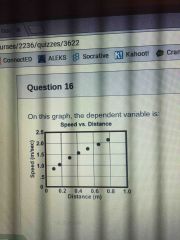
On this graph, the dependent variable is: |
Speed |
|
|
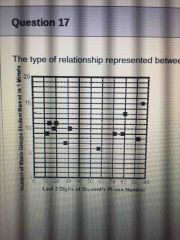
The type of relationship represented between variables in the graph pictured is: |
No relationship |
|
|
|
Centimeter |
The length of your foot |
|
|
|
Meter |
The length of a swimming pool |
|
|
|
Kilometer |
The distance between one town and another |
|
|
|
Millimeter |
The width of a human hair |
|
|
|
I'm one-half hour, A bicyclist traveled 20 km. What was the bicycle is average speed? |
40 km/hr |
S=D/T |
|
|
Speed is: |
All of these (calculated by dividing the distance traveled by the time taken, zero to object at rest, a measure of how quickly an object gets from one place to another.) |
|
|
|
What is the speed of a jet plane to that travels 3,000 meters in 10 second? |
300 m/sec |
|
|
|
If the average speed of a drag racing car is 0.069 mi./s, how long would it take the car to complete a 1/4 mile (0.25 mile) straight track? |
3.6 seconds |
T=D/S |
|
|
If an automobile travels at 30 m/s for two minutes, the car has traveled: |
3,600 meter |
3,600 meters |
|
|
A bicycle rider would NOT be accelerating if her: |
Direction and speed were unchanged. |
|
|
|
Rocket sled accelerates from 10 m/s to 50 m/s in two minutes. What is the acceleration of the sled? |
20 m/sec ^2 |
A=Final speed-starting speed/ Time |
|
|
The slope of the position vs. time graph is equal to: |
Speed |
|
|
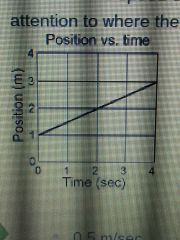
Calculate the speed of an object from the position versus time graph shown above. (Pay attention to where the motion begins) |
0.5 m/sec |
|
|
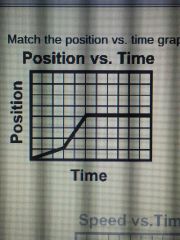
Match the position vs. time graph with correct speed vs. time graph. |

Back (Definition) |
|
|
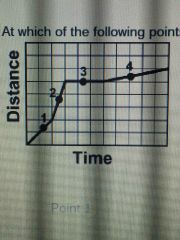
Define points on the graph is the speed the greatest? |
Point 2 |
|
|
|
In this speed versus time graph, the object at point C: |
Has negative acceleration. |
|
|
|
The value calculated by dividing the distance traveled by the time taken to travel that distance is referred to as __________. |
Speed |
|
|
|
The speed you have at a specific point in your journey is best called _______ Speed. |
Instantaneous |
|
|
|
The rate of change in the speed of an object is called ____________. |
Acceleration |
|
|
|
What happens when we slow down? |
• any time speed changes, acceleration occurs. • even slowing down= acceleration. • slowing down causes negative acceleration. |
|
|
|
Object tends to resist change in motion. This property is called: |
Inertia |
|
|
|
Compared to your weight on earth. If you were in the moon: |
Your weight would be less, but your mass would remain the same. |
|
|
|
Newton's first law is also known as: |
The law of Inertia. |
|
|
|
The cart is rolling down a ramp. If the angle of the ramp is increase to make the ramp steeper, the cart will: |
Accelerate faster. |
|
|
|
What is the mass of a rock that weighs 49 Newtons? |
5 kilograms. |
(5* 9.8 or 49/9.8) |
|
|
A tow truck pulls a 2000 kg car with a net force of 4000 N. What is the acceleration of the car? |
2 m/sec^2 |
A=F/M? |
|
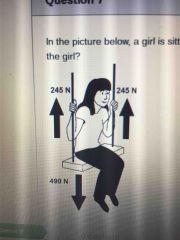
•What is the net force on the girl? |
0 N |
|
|
|
A 200-kilogram rocket accelerates at 50m/sec^2. How large is the net force required to cause an acceleration of this size? |
10000 N |
F=M*A |
|
|
What is Newton's second law? |
F=M*A |
|
|
|
What is Newton's third law? |
For every action there is an equal and opposite reaction. |
|
|
|
Forces occur in _____. |
Pairs |
|
|
|
If those pairs ARE BALANCED, __ _______ _____. |
No movement occurs. |
|
|
|
If pairs ARE NOT EQUAL, _______ _____. |
Movement occurs. |
|
|
|
Momentum? |
Measurement of an object speed multiplied by mass.
Unit is Kg* m/sec= 1 hendren |
|
|
|
Gravity? |
Force applied by an object mass. (The larger the mass the larger the force of gravity.) Weight= M*G |
|
|
|
Scientific method: |
1. Observe the opportunity/problem. 2. Become educated on topic. 3. Form a Hypothesis. 4. Design an experiment. -experiment must test hypothesis. 5. Conclusion & Communication -evaluate your hypothesis (show proof) -data should be Clear & Short. 6. Graphs/ Presentation need to be simple reads. |
|
|
|
What is the difference between mass and weight? |
Mas |
|
|
|
A cars traveling down a straight stretch of highway at 90 km/h. The driver suddenly slams on the brake and brings the car to a quick stop. As a result, then belted passenger well at first: |
Continue to move forward in a straight line. |
|
|
|
On the surface of the Earth, he force of gravity on one kilogram is: |
9.8 Newtons |
|
|
|
The acceleration due to gravity is approximately 10 m/s squared. If a golf ball is drop from the 13th floor of a building, ignoring air resistance, after falling for three seconds the speed of the ball will be: |
30 m/sec |
10*3= 30 |
|
|
A book rests on a table. The force of gravity pulls down on the book with a force of 20 N. What prevents the book from accelerating downward at 9.8 m/s squared? |
The table presses back up on the book with an equal and opposite force of 20 Newtons. |
|
|
|
A rocket can fly into space because: |
The rocket pushes the exhaust gases backwards, and there is an equal an opposite reaction pushing the rocket forward. |
|
|
|
A stationary object has: |
Inertia but no momentum |
|
|
|
What is the momentum of a 0.15 kg baseball moving at 20 m/s? |
3 kg*m/sec. |
P=M*V |
|
|
A 0.15 kg baseball and a 7.25 kilogram bowling ball are both rolling along at 3 m/s. Which object is easier to stop and why? |
The baseball because it has less Interia. |
|
|
|
What are the four types of friction? |
•sliding •rolling •Fluid friction(air or liquid) •static |
|
|
|
A simple machine often multiplies your:
|
force
|
|
|
|
The human arm is an example of which class of lever?
|
Third class
|
|
|
|
Which of the following levers has the largest mechanical advantage?
|
Lever A
|
|
|
|
The engineering cycle describes how an invention gets from concept to reality. Which of the following best describes the order of steps in the engineering cycle?
|
Design
build a prototype Test Evaluate |
|
|
|
Work may be measured using units of:
|
joules
|
|
|
|
The efficiency of a machine is usually expressed in:
|
percent
|
|
|
|
In science, work is defined as:
|
force multiplied by the distance moved in a direction parallel to the force
|
|
|
|
Calculate the work needed to lift a block weighing 4 newtons a distance of 10 meters.
|
40 joules
|
|
|
|
How much power is necessary to do 50 joules of work in 5 seconds?
|
10 watts
|
|
|
|
The efficiency of a modern bicycle is 95 percent. If you exert 200 joules in pedaling a bicycle on level ground, what is the work output?
|
190 joules
|
|
|
|
A gallon of gasoline contains chemical energy. If you pour a gallon of gasoline into your car, you could drive for about 20 miles on the highway (about 20 minutes). You could choose instead to run a lawn mower for an hour with one gallon of gasoline. If the gasoline were to come in contact with a fire, the entire gallon would burn in less than a minute. Which reaction has the most power?
|
Burning the gasoline in a fire
|
|
|
|
Which of the following is NOT considered a simple machine?
|
Electric motor
|
|
|
|
The efficiency of most machines is less than 100 percent. Due to friction, energy seems to be lost. While the energy is not truly lost, it does work that is not useful or is converted to:
|
thermal energy
|
|
|
|
When a ball is thrown into the air, the potential energy gained must come from its kinetic energy. As the ball gains potential energy, its speed will:
|
decrease
|
|
|
|
A marble rolls along the track below with no friction. The sequence of positions on the track listed in order from the lowest kinetic energy to the highest kinetic energy is:
|
1, 5, 4, 2, 3, 6
|
|
|
|
A system of pulleys is used to lift an elevator carrying a 3,300-newton load. Assuming the pulley system is nearly friction-free, approximately how far would 10,000 joules of energy lift the elevator?
|
3 meters
|
|
|
|
While sitting next to a campfire, Susan noticed several different forms of energy being transformed from the potential chemical energy of the wood. She correctly named all of the following forms of energy except:
|
nuclear
|
|
|
|
Potential energy is energy due to the:
|
height of an object
|
|
|
|
As a car is slowed, most of its kinetic energy is converted by the brakes to:
|
thermal energy.
|
|
|
|
Exercise may transform the chemical energy in the food you eat into:
|
both kinetic and potential energy
|
|
|
|
Which of the following block and tackle systems has the largest mechanical advantage?
|
System C has the largest mechanical advantage
|
|
|
|
A simple machine has an input force of 10 newtons and an output force of 100 newtons. What is the mechanical advantage of the simple machine?
|
10
|
|
|
|
A block and tackle system has an input force of 2.5 newtons and an output force of 10 newtons. What is the mechanical advantage of the system?
|
4
|
|
|
|
On a 10-speed bicycle, gears increase the mechanical advantage of the bicycle. In which of the following situations would you want the greatest mechanical advantage for the gear system?
|
Climbing up a hill
|
|
|
|
A block and tackle machine is used to lift a box that weighs 90 newtons. How much force do you need to pull on the rope if the machine has a mechanical advantage of 5?
|
18 newtons
|
|
|
|
A lever rotates around a fixed point called a:
|
fulcrum
|
|
|
|
If the output force of a lever is located between the fulcrum and input force, the lever is a:
|
second class lever
|
|
|
|
Ratio of the output force to the input force
|
Mechanical Advantage |
|
|
|
Testable model of conceptual design
|
prototype |
|
|
|
Application of science to solve problems
|
engineering |
|
|
|
Point around which a lever rotates
|
fulcrum |
|
|
|
Part of a lever that moves a rock, for example, when you apply a force
|
arm |
|
|
|
Human arms and legs are examples
|
Third class lever |
|
|
|
Force you apply to make a simple machine work
|
input force |
|
|
|
The force a machine applies to accomplish a task
|
output force |
|
|
|
The amount of work performed over time
|
power |
|
|
|
Stored work
|
energy |
|
|
|
A force being applied over a distance
|
work |
|
|
|
Jennifer, who weighs 450 newtons, and Judy, who weighs 600 newtons, are standing at the bottom of a flight of stairs that is 4.00 meters high. Jennifer runs up the stairs in 2.0 seconds. Judy runs up the same stairs in 4.0 seconds. Compare the work done and the power generated by each girl’s run up the stairs. Be sure to include a unit with your answer.
a. How much work does Judy do? b. How much work does Jennifer do? c. Who does more work? Just type the name of the person. d. How much power does Judy do? e. How much power does Jennifer do? f. Who is more powerful? Just type the name of the person. |
a. 2400 Joules b. 1800 Joules c. Judy d. 600 Watts e. 900 Watts f. Jennifer |
|
|
|
Calculate the work done when a 50 newton object is lifted 5 meters using a block and tackle. Be sure to include the correct unit with your answer.
|
250 Joules |
|
|
|
When the forces on an object are balanced, we say that the object:
|
is in equilibrium.
|
|

